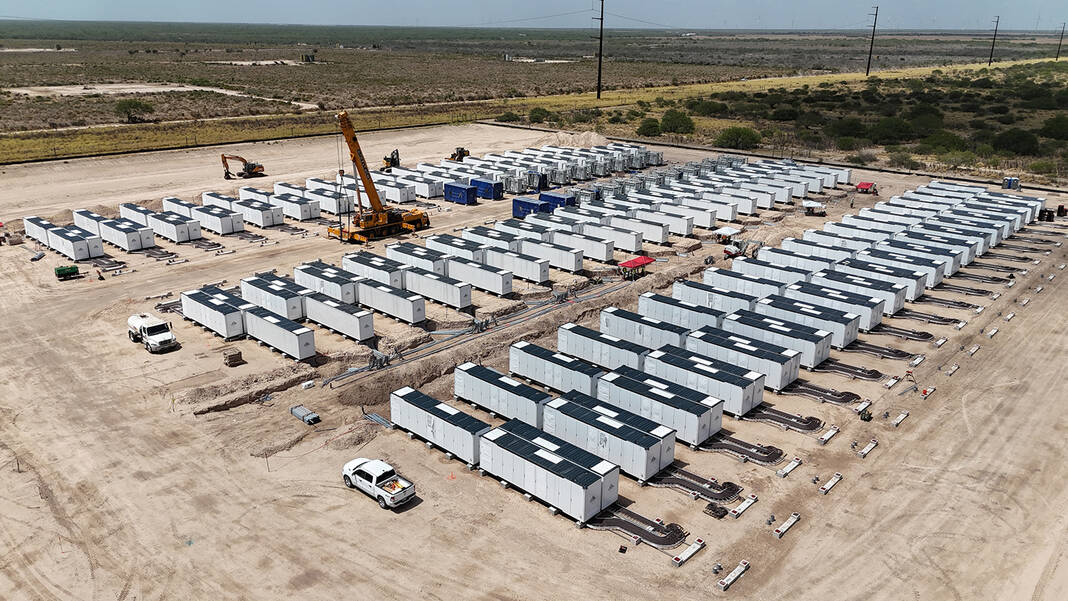|
Only have a minute? Listen instead
Getting your Trinity Audio player ready...
|
Hidalgo County officials on Tuesday unanimously approved a five-year, multi-million dollar tax abatement agreement with Anemoi Energy, a Delaware-based company which is building an electric battery storage facility just south of McCook.
However, the tax break for the $190 million project, which is receiving significant funding from the North American Development Bank (NADBank) and First Citizens Bank, came with little public input.
Hidalgo County Judge Richard F. Cortez had stepped away from the dais shortly before the commission voted on the agreement.
“I wanna tell you that we appreciate you coming to Hidalgo County — specifically, Precinct 3. I know that this property was generating … almost zero dollars in the past because it was ag use, and now it’s gonna be generating a lot for our taxpayers,” Hidalgo County Precinct 3 Commissioner Everardo “Ever” Villarreal said just before the vote.
The storage facility is being constructed on a 19.4-acre portion of farmland south of McCook near fields that are already dotted with dozens of electricity-producing wind turbines.
Converting the land from agricultural use to an energy facility means Hidalgo County will reap a slew of benefits via the increase in the property’s valuation.
“If there was no abatement, we would be getting about $27,000 on taxes for the five years. But, with the improvements, it’s gonna be about $6 million of taxes,” a county staffer explained.
Under the terms of the agreement, Hidalgo County will abate 50% of the facility and the land’s value for the next five years. Both parties further agreed that the facility will be valued at at least $166 million for the first year of the agreement.
Though the tax abatement agreement lists the estimated value of the project at $190 million, NADBank announced in its October news release that it had joined a consortium of lenders to provide $202.3 million in financing on the project.
NADBank alone pledged to lend Anemoi up to $40 million, according to the financing proposal.
The North American Development Bank is a binational endeavor created between the United States and Mexican governments to fund largescale infrastructure projects.
HOW IT WORKS
The battery storage system, also called a “BESS,” will have a capacity of 200 megawatts of alternating current that will be able to provide power for up to two hours, according to an Oct. 18 NADBank news release.
The batteries will be able to store and send energy into the Texas electric grid thanks to a nearby substation called the Pomelo Substation.
Officials hope the batteries will serve as both a failsafe during broader power grid disruptions, and reduce greenhouse gas emissions by reducing the use of fossil fuel-based power generators during “ramp up” and “ramp down” periods as the grid adjusts to fluctuating demand.
The battery storage facility is expected to store more than 118,000 megawatt-hours of energy per year, according to a certification and financing proposal NADBank published in July. That’s enough electricity to power more than 28,000 homes.
Its 176 lithium-ion phosphate batteries are also expected to displace more than 50,500 metric tons of carbon dioxide, 38 metric tons of nitrogen oxide and 38 tons of sulfur dioxide per year.
The project has been in the works since at least 2021, when Plus Power — headquartered in The Woodlands and Anemoi’s parent company — first conducted an interconnectability study in November of that year, according to the NADBank financing proposal.
Plus Power bought the land for the storage facility through a purchase option agreement in August 2021 that was later amended in September 2022. Construction began this May and the facility is expected to be operation by April 2024.
The county issued the company a commercial permit on May 16, according to the financing proposal.
LITTLE PUBLIC DISCUSSION
Meanwhile, earlier this summer, the county published a notice that officials would be discussing a tax abatement agreement at a July 25 commissioners’ court meeting, but that discussion was never held.
Instead, County Administrator Valde Guerra explained to the commissioners that no action would be taken at that time, and that he would privately address a concern from local government watchdog, Fern McClagherty, who had signed up to speak during the discussion.
The matter did not come up again publicly until Tuesday’s commission meeting.
There, a county staffer stated that the commissioners had already discussed the issue during its previous meeting on Nov. 14 and that there was no need to discuss it further.
The commissioners needed only to vote on the tax abatement proposal, he said.
But if officials had made plans to discuss the tax abatement agreement during the Nov. 14 meeting, Hidalgo County residents would have been hard pressed to discern that from the official meeting agenda.
Nowhere does the agenda list Anemoi Energy, battery storage, or tax abatements.
Instead, the sole clue taxpayers had that a multimillion-dollar tax break was on the line lay hidden at bottom of the agenda, in the portion reserved for executive session.
There, Item 28D reads, “Deliberation regarding the following Economic Development Negotiations pursuant to Chapter 551, Texas Government Code, Section 551.087: Project Anne.”
Like all items on an executive session portion of a meeting agenda, that discussion occurred out of the public’s view.
The Texas Open Meetings Act, which is also known as Chapter 551, allows local governmental entities narrow exceptions to discuss certain matters behind closed doors.
Those exceptions are limited to things such as conferring with an attorney for legal advice, negotiating real estate deals, or — as in this case — discussing economic incentives.
However, in July, NADBank solicited public input on its website, where it hosted a 30-day commenting period, and probed for public sentiment on the proposal, but found none.
“NADBank also conducted a media search to identify potential public opinion about the Project. No specific articles or references to the Project were found. No public opposition to the Project has been detected,” the financing proposal states.




